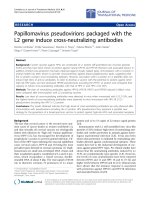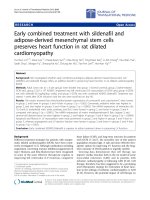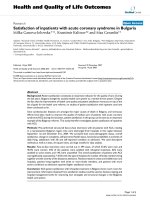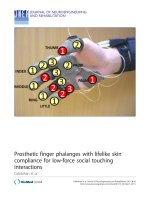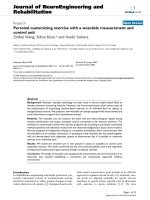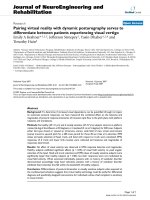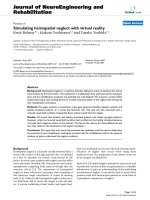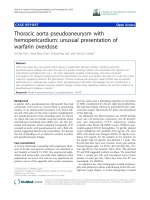Báo cáo hóa học: " Error-resilient video coding with end-to-end ratedistortion optimized at macroblock level" doc
Bạn đang xem bản rút gọn của tài liệu. Xem và tải ngay bản đầy đủ của tài liệu tại đây (1.86 MB, 10 trang )
RESEARCH Open Access
Error-resilient video coding with end-to-end rate-
distortion optimized at macroblock level
Jimin Xiao
1,2
, Tammam Tillo
2*
, Chunyu Lin
3
and Yao Zhao
3
Abstract
Intra macroblock refreshment is an effective approach for error-resilient video coding. In this paper, in addition to
intra coding, we propose to add two macroblock coding modes to enhance the transmission robustness of the
coded bitstream, which are inter coding with redundant macroblock and intra coding with redundant macroblock.
The sel ection of coding modes and the parameters for coding the redundant version of the macroblock are
determined by the rate-distortion optimization. It is worth mentioning that the end-to-end distortion is employed
in the optimization procedure, which considers the channel conditions. Extensive simulation results show that the
proposed approach outperforms other error-resilient approaches significantly; for some video sequences, the
average PSNR can be up to 4 dB higher than that of the Optimal Intra Refreshment approach.
Keywords: H.264/AVC, error resilience, end-to-end distortion, intra refreshment, redundant coding
I. Introduction
The H.264/AVC [1] video coding standard provides
higher coding efficiency and stronger network adapta-
tion capability in comparison with all the previously
developed video coding standard s. However, as previous
video compression standards, it is based on a hybrid
coding method, w hich uses transform coding with
Motion-Compensated Prediction (MCP). Therefore,
when the hybrid-coded video bit-str eam is transmitted
over packet loss networks, it suffers from error propaga-
tions and this leads to the well-known drifting phenom-
enon [2,3].
Due to the unreliable underlying networks, the devel-
opment of error-resilient techniques is a crucial require-
ment for video communication over lossy networks. For
applications that can tolerate long delay, channel-coding
techniques, like Forward Error Correction (FEC), pro-
vide very significant reductions of transmission errors at
a comparably moderate bitrate overhead. For the real-
time applica tions, however, the effec tive use of FEC and
re-transmission is limited. Here, the use of error resili-
ence techniques in the source codec becomes important.
Two categories of source coding approaches are
promising. One category is based on intra macroblock
refreshment, and another one is redundant coding.
The intra macroblock refreshment approach is stan-
dard compatible, and it is a useful tool to combat net-
work packet losses. It can be employed to weaken the
inter picture dependency due to inter prediction, and
eventually, cut-off the error propagations. The early
intra macroblock refreshment algorithms are based on
randomly inserting intra macroblocks [ 4] or periodical ly
inserting intra contiguous macroblocks [5]. However, in
both [4] and [5], the intra refresh frequency is deter-
mined in a heuristic way, and as the intra coding mode
is costly, the trade-off between code efficiency and error
resiliency need to be balanced. Zhang et al. [6] first trea-
ted this problem as optimal coding mode selection of
macroblocks and proposed the well-known Recursive
Optimal Per-pixel Estimate (ROPE) approach to deter-
mine where to insert intra macroblock. In [6], the
expected end-to-end distortion for each pixel is c alcu-
lated in rec ursive way, and then in the mode selection
step, the expected end-to-end distortion is used in the
rate-distortion optimization process. In [7], another flex-
ible intra macroblock update algorithm was investigated
to optimize the expected rate-distortion performance. In
this approach, the end-to-end distortion is calculated by
emulating the real channel behavior; therefore, the com-
putation overhead is tremendous. T he work in [6,7] is
* Correspondence:
2
Department of Electrical and Electronic Engineering, Xi’an Jiaotong-
Liverpool University, 111 Ren Ai Road, Suzhou, People’s Republic of China
Full list of author information is available at the end of the article
Xiao et al. EURASIP Journal on Advances in Signal Processing 2011, 2011:80
/>© 2011 Xia o et al; licen see Springer. This is an Open Access article distributed under the terms of the Creative Commons Attribution
License ( which permits unrestricted use, distribution, and reproduction in any medium,
provided the original work is properly cited.
loss-aware end-to-end rate-distortion optimized intra
macroblock refreshment algorithm, which is currently
the best known way for determining both the correct
number and p lacement of intra macroblocks for error
resilience.
Redundant coding is another effective tool for robust
video communication over lossy network. In [8], an
optimal algorithm is presented to determined whether
one picture needs redundant version. In [9], redundant
slice is optimally allocated based on the sli ce position in
the GOP, and the primary and redundant slices are then
interleaved to generate two equal importance descrip-
tions using the MDC [10] diagram. Whereas in [11], the
two descriptions are generated by splitting the video pic-
tures into two threads, and then redundant pictures are
periodically inserted into the two threads. In both [8]
and [11], redundant coding are optimized in frame level,
namely all the macroblocks in one frame is encoded
with the same redundant coding parameters, whereas
for [9], redundant information is allocated in slice level.
In [12], redundant coding is optimized in macroblock
level. However, in order to optimally tune the redun-
dancy, this approach needs all the motion vector infor-
mation in one GOP, which leads to a delay of one GOP;
consequently, this work cannot be applied in real-time
applications, such as video conference.
Intra macroblock refreshment can stop errors in the
previous frames, while redundant coding is a way of pre-
venting errors in the future frames. In order to take
advantage of the two approaches, we propose to add
two new encoding modes, namely inter coding with
redundan t macroblock and intra coding with redundant
macroblock, in addition to the conventional intra and
inter coding modes. This approach is called Hybrid
Redundant Macroblock and Intra macroblock Refresh-
ment (HRMIR). The redundant version macroblock is
encoded with l ower quality and rate, which is imple-
mented by scaling the quantization parameter (QP). The
selection of coding modes and the parameters for c od-
ing the redundant version of the macroblock are deter-
mined by the rate-distortion o ptimization procedure. It
is worth noticing, the loss-aware end-to-end expected
distortion is used for t he RD optimization, and the end-
to-end distortion is cal culated with the ROP E [ 6]
method. Since calculating the end-to-end distortion with
the ROPE method causes no additional delay, the pro-
posed approach is suitable for real-time applications.
The rest of the paper is organized as follows. In Sec-
tion II, the method to calculate the loss-aware end-to-
end distortion is presented. In Section III, the proposed
HRMIR approach is introduced. In Section IV, extensive
simulation results are given, which validate our
approach. Finally, some conclusions are drawn in Sec-
tion V.
II. End-to-end distortion calculation
In an ideal error-free enviro nment, the rate-distortion
optimized i ntra/inter mode decision is an efficient tool
to determine the macroblock mode based on the cost
function defined in [13], and the cost function of any
macroblocks is defined as
J
MB
=
D
MB
+ λ
m
ode
·
R
M
B
(1)
where l
mode
is the Lagrange multiplier, D
MB
and R
MB
are the encoding distortion and the bitrate in different
encoding modes, respectively. This optimization mode is
tailored for error-free environment, and no channel
packet loss is considered here.
However, when the compressed video is transmitted
over error-prone network, in addition to the distortion
caused by source coding, there is channel distortion,
which is caused by packet loss of the underlying network.
Loss-aware end-to-end distor tion, which encompasses
both of the two categories distortion, is used in the pro-
posed HRMIR approach to make better RD optimization.
There are many methods to calculate the end-to-end dis-
tortion, in ROPE [6], end-to-end distortion for each pixel
is calculated in recursive way. Recent advances in ROPE
further expand its capability to accommodate sub-pixel
prediction [14] and burst packet loss [15]. In [16], a block-
based approach generates and recursively updates a block-
level distortion map for each frame; therefore, the end-to-
end distortion is calculated in block-level. Besides calculat-
ing end-to-end in the pixel domain, compressed-do main
methods are introduced in [17]. It is important to note
that, for the sake of complexity reduction, we apply ROPE
[6] with full-pixel level accuracy in our HRMIR approach.
For the sub-pixel version ROPE method [14], the compu-
tation of the second moment needs a large amount of sto-
rage capacity and computational power, which renders the
whole p rocess utterly formidable. Furthermore, con-
strained intra prediction is applied, so there is no error
propagation in the intra prediction.
Let
f
i
n
denote the original value of pixel i in frame n,
and let
ˆ
f
i
n
and
˜
f
i
n
denote its encoder and decoder recon-
struction, respectively. Because of possible pa cket loss in
the channel,
˜
f
i
n
can be modele d at the encoder side as a
random variable. In the ROPE approach, the D
MB
is
redefined as the overall expected decoder distortion in
one macroblock.
D
MB
=
i∈
MB
d
i
n
(2)
d
i
n
= E
f
i
n
−
˜
f
i
n
2
=(f
i
n
)
2
− 2 · f
i
n
· E
˜
f
i
n
+ E
˜
f
i
n
2
(3)
Xiao et al. EURASIP Journal on Advances in Signal Processing 2011, 2011:80
/>Page 2 of 10
The overall expected mean-squared-error (MSE) dis-
tortion of a pixel is
d
i
n
; obviously, it is determined by the
first and second moments of the decoder reconstruction.
ROPE provides an optimal recursive algorithm t o accu-
rately calculate the two moments for each pixel in a
frame.
Let us assume that packet loss events are independ ent
for simplicity, and the packet loss rate (PLR) p is avail-
able at the encoder, usually the encoder can get the sta-
tistics of packet loss through RTCP [18]. To make it
more general, we will not impose any li mitations on the
slice s hape and size, so the motion vectors from neigh-
boring macroblocks are not always available in the error
concealment stage. Therefore, the decoder may not be
able to use motion vector from neighboring macro-
blocks for concealment. Accordingly, we assume the
decoder copies reconstructed pixels from the previous
frame for concealment. The prediction at the encoder
only employs the previous reconstructed frame. The
recursive formulate of ROPE is as follows.
• Pixel in the intra macroblock
E
˜
f
i
n
=(1− p)
ˆ
f
i
n
+ pE
˜
f
i
n−1
(4)
E
˜
f
i
n
2
=(1− p)
ˆ
f
i
n
2
+ pE
˜
f
i
n−1
2
(5)
• Pixel in the inter macroblock
E
˜
f
i
n
=(1− p)
ˆ
e
i
n
+ E
˜
f
i+mv
n−1
+pE
˜
f
i
n−1
(6)
E
˜
f
i
n
2
=(1− p)
(
ˆ
e
i
n
)
2
+2
ˆ
e
i
n
E
˜
f
i+mv
n−1
+E
˜
f
i+mv
n−1
2
+pE
˜
f
i
n−1
2
(7)
where inter coded pixel i is predicted from pixel i +
mv in the previous frame. The prediction residual
e
i
n
is
quantized to
ˆ
e
i
n
.
III. The proposed HRMIR approach
As redundant coding and intra macroblock refreshment
are both powerful tools for error resiliency video com-
munication, in the proposed approach, they are hybridly
applied to further protect the video s tream. With the
Hybrid Redundant Macroblock and Intra macroblock
Refreshment (HRMIR) approach, all the macroblocks of
one frame are divided into four types, namely intra
macroblock, inter macroblock, inter macroblock with
redundant version and intra macroblock with redundant
version. The redundant version macroblocks are encap-
sulated in the redundant picture. It is important to note
that the concept of redund ant slice is part of the H.264/
AVC standard. In order to make the proposed approach
fully compatible with the H.264/AVC standard, for
those macroblocks without redundant version, SKIP
mode could be used. Let us take macroblocks in Figure
1 as an example, suppose that the last macroblock in
the first row is an inter macroblock with redundant ver-
sion; accordingly, the redundant macroblock is stored in
the redundant picture. Therefore, for macroblock with
redundant version, if the macroblock in the primary pic-
ture is lost due to packet loss, the redundant version
can be used to replace the macroblock. On the contrary,
for intra macroblock and inter macroblock without
redundant version, there will be no redundant informa-
tion to be sent in the redundant picture.
It is worth noticing that, in general, the redundant
version macroblock is encoded with lower bit rate than
primary one, so the video quality is also lower than pri-
mary one. In our approach, this is im plemented by set-
ting a relative larger quantization parameter (QP) for
redundant version macroblock. Like the selection of the
coding type for each macroblock, the selection of the
appropriate QP value for redundant macroblock is also
optimized in the end-to-end RD optimization process.
Figure 2 shows th e QP value for redundant frame in the
Foreman CIF sequence, where the QP of primary
Figure 1 Four types of macroblocks in one frame, 1 stands for
inter macroblock, 2 stands for intra macroblock, 3 stands for
inter macroblock with redundant version and 4 stands for intra
macroblock with redundant version. The redundant version
macroblocks are encapsulated in the redundant picture.
Xiao et al. EURASIP Journal on Advances in Signal Processing 2011, 2011:80
/>Page 3 of 10
macroblock is 22. In order to present all information in
one figure, we use positive number for inte r macroblock
and negative number for intra macroblock. The valid
QP range is (1-51) in H.264/AVC, so we use 60 to
denote inter macrobloc k without redundant version and
-60 to denote intra macroblock without redundant ver-
sion. For example, if a macroblock in Figure 2 has a
value -34, this means it is an intra macroblock w ith QP
34, whereas for a macroblock with value 34, it is an
inter macroblock with QP 34. It can be seen that most
of the background areas are encoded with inter coding
without redundant version, because these areas are rela-
tively static, and with the temporal replacement conceal-
ment algorithm, losing these areas will not lead to huge
distortion. On the contrary, the parts of foreground,
which is the Foreman face area in this frame, are
strongly protected with intra coding and/or redundant
coding. Note b oth the macroblo ck type and QP value
are optimized in the RD optimization process, which are
presented in the next section.
A. The HRMIR rate-distortion optimization
As in the other encoding approaches, in the HRMIR
rate-distortion optimization process, the encoder selects
the coding option O* for current macroblock, s o that
the Lagrangian cost function is minimized.
O
∗
= arg min
o∈
HRMIR
(D
MB
(0) +
mode
R
MB
(0)
)
(8)
where D
MB
( o) is the expected end-to-end distortion
for mode o, R
MB
(o) is the rate for this mode and l
mode
is the Lagrangian multipl ier. Γ
HRMIR
is a set of encod-
ing options, which includes all encoding modes. For
the original ROPE approach, the available encoding
modes includes intra mode I and inter mode P,so
Γ
ROPE
={I, P}. However, in our HRMIR approach,
there are two new modes. They are intra mode with
redundant version macroblock and inter mode with
redundant version macroblock. For simplicity, let us
use
I
u
r
and
P
v
r
to denote the two new modes, respec-
tively, with r standing for redundant coding, u repre-
senting the candidate QP value in the intra redundant
coding and v representing the candidate QP value in
the inter re dundant coding. The refore, for the HRMIR
approach, the set of encoding options become
HRMIR
= {I, P, I
u
r
, P
v
r
}
. In general, the QP value of
redundant coding is larger than that of primary coding.
Let us use QP
I
and QP
P
to denote the primary QP
value of intra and inter coding, respectively. In the
redundant coding, candidate QP value is u Î {u|QP
I
≤
u ≤ 51} and v Î {v|QP
P
≤ v ≤ 51}, where 51 is the max-
imum QP value in H.264/AVC [1].
B. The HRMIR end-to-end distortion and rate
When calculating the expected end-to-end distortion,
we can still use the Equations 4, 5 for intra macroblock
without redundant coding, and Equations 6, 7 for inter
macroblock without redundant coding. Whereas for
intra macroblock with redundant coding, first and sec-
ond m oments of the decoder reconstruction are as fol-
lows.
E
˜
f
i
n
=(1− p)
ˆ
f
i
n
+ p(1 − p)
ˆ
f
i,
u
n
+ p
2
E
˜
f
i
n−1
(9)
E
˜
f
i
n
2
=(1− p)
ˆ
f
i
n
2
+ p(1 − p)
ˆ
f
i,u
n
2
+ p
2
E
˜
f
i
n−1
2
(10)
where in the primary coding
f
i
n
is quantized to
ˆ
f
i
n
,and
in the redundant coding, it is quantized to
ˆ
f
i,u
n
,hereu is
the redundant QP value.
Similarly, for inter macroblock with redundant coding,
first and second moments of the decoder reconstruction
are as follows.
E
˜
f
i
n
=(1− p)
ˆ
e
i
n
+ E
˜
f
i+mv
n−1
+p(1 − p)
ˆ
e
i,v
n
+ E
˜
f
i+mv(v)
n−1
+p
2
E
˜
f
i
n−1
(11)
Figure 2 Macroblock level QP value of redundant coding for
one frame in the Foreman CIF sequence, positive number for
inter macroblock and negative number for intra macroblock.
We use 60 and hatching to denote inter macroblock without
redundant version and - 60 and hatching to denote intra
macroblock without redundant version.
Xiao et al. EURASIP Journal on Advances in Signal Processing 2011, 2011:80
/>Page 4 of 10
E
˜
f
i
n
2
=(1− p)
(
ˆ
e
i
n
)
2
+2
ˆ
e
i
n
E
˜
f
i+mv
n−1
+E
˜
f
i+mv
n−1
2
+p(1 − p)
(
ˆ
e
i,v
n
)
2
+2
ˆ
e
i,v
n
E
˜
f
i+mv(v)
n−1
+E
˜
f
i+mv(v)
n−1
2
+p
2
E
˜
f
i
n−1
2
(12)
where in the primary coding, pixel i is predict ed from
pixel i + mv in the previous frame, the prediction resi-
dual
e
i
n
is quantized to
ˆ
e
i
n
. In the redundant coding, the
redundant QP value is v, pixel i is predicted from pixel i
+ mv(v) in the previous frame, the prediction residual
e
i
n
is quantized to
ˆ
e
i,
v
n
.
For those intra and inter macroblocks with redundant
coding, the probability of receiving the primary macro-
block is 1 - p. The probability of receiving the redun-
dant macroblock while losing the primary information is
p(1 - p), and the probability of losing both the primary
and redundant macroblocks is p
2
. With all those prob-
abilities, we can easily get Equations 9, 10, 11, 12 for
macroblock with redundant version. It is important to
note that when the macroblock is encoded with redun-
dant version, namely
0 ∈{I
u
r
, P
v
r
}
, t he total bit rate R
MB
(o) is calculated by summing up the bit rate used for
both primary and redundant coding.
C. Lagrange multiplier selection
The Lagrange multiplier l
mode
in (8) controls the rate-
distortion trade- off. For the error-prone environment,
extensive experimental evidence suggests that there is
no significant performance difference between using the
Lagrange multiplier tailored to the error-free or the
error-prone environment. This argument has also been
confirmed in [7]. So l
mode
is set as the one tailored to
error-free environment.
m
ode
=0.85× 2
(QP−12)/
3
(13)
where QP is the quantization parameter.
D. Computation complexity reduction
In the HRMIR rate-distortion optimization procedure, in
order to find the optimal QP value for redundant cod-
ing, we need to calculate the rate-distortion cost for all
possible redundant QP value; therefore, the computation
complexity is tremendous. For example, let us assume
the p rimary QP value is 22, in the RDO procedure
described in Section III-A, the encoding options are
HRMIR
= {I, P, I
u
r
, P
v
r
}
, then both
I
u
r
and
P
v
r
have (51 -
22 + 1) possible redundant QP values, here 51 is the
maximum QP value in H.264/AVC. Therefore, Γ
HRMIR
includes 62 encoding options (both
I
u
r
and
P
v
r
have 30
QP values plus intra/inter coding without redundant
version).
By lowing the number of encoding options, the com-
putation complexity will be reduced. Let us s et the
redundant QP increase step a s QP
step
,thenthecandi-
date QP value would be u Î {u|u = QP
I
+ K × QP
step
, u
≤ 51, K = 0, 1, 2, } and v Î {v|v = QP
P
+ K × QP
step
, v
≤ 51, K = 0, 1, 2, }.
In Figure 3, the trade-off between PSNR and compu-
tation complexity is reported. It is observed that when
the value of QP
step
issetas5and10,thePSNRislower
than that when the QP
step
is 1. However, the PSNR
decrease is very limited. The computation overhead for
the QP
step
= 5 case is nearly 1/5 of that for the QP
step
=1
case, but the resulting decrease of PSNR is less than 0.3
dB.EvenwhentheQP
step
value is set to 10, the PSNR
penalty is less than 0.5 dB. The indication of this prop-
erty of HRMIR is significant, which means it is possible
to deploy this approach in hand-device, where the com-
putation resource is limited, by setting relatively large
QP
step
value.
IV. Simulation result
Our simulation setting builds on the JM9.4 H.264 co dec
[19]. We use constrained intra prediction and C ABAC
for entropy coding, and fixed QP value is used for all of
our simulations. One row of macroblocks per slice is
used to create slices. For each sequence, only the first
frame is coded as I-frame, and the rest are coded as P-
frames; the reference frame number is 1. In order to
have fair comparison with the Optimal Intra approach
Figure 3 PSNR versus bit rate for the Foreman sequence, QP
step
of HRMIR is set to 1, 5, 10. PLR is set to 10%, and GOP is 30.
Xiao et al. EURASIP Journal on Advances in Signal Processing 2011, 2011:80
/>Page 5 of 10
[6], it is assumed that the I-frame is transmitted over
secure channel. We use the average luminance PSNR to
assess the objective video quality; the mean squared
error (mse) is averaged over 200 trials, then the value of
PSNR is calculated based on the averaged mse. A ran-
dom packet loss generator is used to drop the packets
according to the required packet loss rate. For the lost
slices, temporal re placement concealment is used, which
means the pixel value of lost slice is copied from the
same position in the previous frame. To evaluate the
proposed HRMIR approach, extensive experi ments have
been conducted, and as benchmark, we use conventional
Optimal Intra Refreshment [6] and RS-MDC [9] for
comparison.
In the first set of e xperiment, frame-by-frame aver-
age PNSR is reported for Foreman and Bus CIF video
sequences. We compare HRMIR results with Optimal
Intra [6] and RS-MDC [9]. In this experiment, constant
QP value is used. For the HRMIR approach, QP i s set
to 22 and 28 for Foreman and Bus, respectively, while
for the other two approaches, the encoded bitrate is
close to but no less than that of HRMIR approach. In
Figure 4, full-pixel accuracy motion estimation (ME) is
used, whereas in Figure 5, motion estimation with 1/4
pixel accuracy is adopted. In both full-pixel and sub-
pixel motion estimation environments, the video qual-
ity of HRMIR and RS-MDC is similar at the beginning
of several v ideo frames for both the Foreman and Bus
sequences. However, the video quality of RS-MDC
decreases much faster than that of HRMIR; therefore,
HRMIR outperforms RS-MDC significantly with frame
number increasing. This result indicates that for those
P-frames relatively far away from the intra frame, only
providing redundant coding is not enough t o protect
the video quality effectively. Meanwhile, when compar-
ing HRMIR with Optimal Intra, for m ost of the frames,
PSNR of HRMIR is higher than that of Optimal Intra.
Another advantage of the HRMIR approach is t hat the
video quality for each frameismorestablethanthe
other two approaches, which is an essential character-
istic of subjective h igh-quality video. When the enco-
der adopts sub-pixel ME, the accuracy of the end-to-
end distortion calculated with the ROPE [6] method is
compromised, and eventually, the optimal procedure in
Section III-A becomes sub-optimal. However, compar-
ing results in Figure 4 with that in Figure 5, it is found
that in both full-pixel ME and sub-pixel ME environ-
ments, HRMIR outperforms Optimal Intra and RS-
MDC, and the superiority of HRMIR over the other
two approaches remains almost unchanged in the sub-
pixel ME environment. Therefore, in the following
experiments, we adopt the sub-pixel ME with the pur-
pose of good performance in the sense of rate-
distortion.
Figure 6 shows the video quality versus bit rates for
CIF video sequences Foreman and Bus. Different QP
values are selected in order to span a considerable range
of coding rates. In Figure 6, we fix t he PLR as 10% and
GOP length is set to 15 and 30. It is observed that when
GOP is 15, HRMIR has slight advantage over RS-MDC,
whereas when the GOP is 30, HRMIR outperforms RS-
MDC significantly. In Figure 7, we fix the GOP length
as 30 an d PLR is set to 5 and 10%. It is interesting to
see that when the PLR is 10%, the superiority of
HRMIR over RS-MDC is larger than the case that when
Figure 4 Frame-by-frame average PSNR comparison for HRMIR,
Optimal Intra and RS-MDC, PLR is 10%, full-pixel accuracy
motion estimation a Forman CIF 30 fps, 2.12 Mbps. b Bus CIF
30 fps, 2.88 Mbps.
Xiao et al. EURASIP Journal on Advances in Signal Processing 2011, 2011:80
/>Page 6 of 10
PLR is 5%. This phenomenon is because with long GOP
and high packet loss rate, only providing redundant
information cannot protect the video quality properly.
Furthermore, for both the Foreman and Bus sequences,
the HRMIR provides much higher PSNR t han Optimal
Intra in all the simulation environments. Let us take the
Bus sequence for example, when PLR is 5% and GOP is
30, PSNR of HRMIR is about 4 dB higher than Optimal
Intra with bitrate 2 Mbps. Note that in both Figures 6
and 7, when the bitrate is low, the PSNR of HRMIR and
RS-MDC is nearly same; this is because in this case,
very few Intra macroblocks are inserted, which makes
HRMIR approach similar as RS-MDC approach.
Furthermore, as the QP values of diffe rent macroblocks
in the proposed HRMIR approach are not identical,
additional bits are needed to encode the residual QP
value.
In all the previous expe riments, the channel packet
loss rate is assumed to be available at the encoder, and
this can be implemented with the Real Time Control
Protocol (RTCP) [18]. However, in practical situation,
feedback packet loss rate information may be delayed
from the decoder. Therefore, the packet loss rate used
by the encoder in its RD optimization process may not
Figure 5 Frame-by-frame average PSNR comparison for HRMIR,
Optimal Intra and RS-MDC, PLR is 10%, 1/4-pixel accuracy
motion estimation. a Foreman CIF 30 fps, 1.48 Mbps. b Bus CIF 30
fps, 1.92 Mbps.
Figure 6 PSNR versus bit rate for HRMIR, Optimal Intra and RS-
MDC, PLR is 10%, GOP length N = 15 and 30, a CIF Foreman
sequence, b CIF Bus sequence.
Xiao et al. EURASIP Journal on Advances in Signal Processing 2011, 2011:80
/>Page 7 of 10
be exactly identical to the actual packet loss rate. To
further evaluate the performances of the proposed
HRMIR approach at the case when the estimated packet
loss rate does not match the actual one, we use 10% as
packet loss rate in the RD optimization process, whereas
the actual p acket loss rate is va ried from 0 to 20%. In
Figure8,theHRMIR,OptimalIntraandRS-MDC
approaches are all optimized for 10% packet loss rate.
The encoded bitrate of HRMIR is 1.48 Mbps, whereas
for the other two approaches, the encoded bitrate is
close to but no less than the that of HRMIR approach.
IntheactualPLRrangeof[0-20]%,thePSNRof
HRMIR is the highest among the three a pproaches,
which means when there is PLR mismatch, the HRMIR
still can provide best video quality among the three
approaches. Meanwhile, the gap b etween HRMIR and
RS-MDC increases with actual PLR; therefore, when
actual p acket loss rate is high, RS-MDC fails to protect
the video quality properly.
In Figure 9, we study how intra macroblocks are allo-
cated in two different encoding approaches. CIF
sequence Foreman is used, QP is set to 28, and the first
50 frames are used. Interestingly, the total percentage of
intra macroblocks (both i ntra macroblocks with and
Figure 8 Performance comparison for HRMIR, Optimal Intra
and RS-MDC when there is PLR mismatch between encoding
stage and practical network situation, Foreman sequence is
used, GOP is 30, the estimated PLR is 10%, while the actual
PLR is varied from 0 to 20%, bitrate is 1.48 Mbps.
Figure 9 Percentage of intra macroblock for HRMIR and
Optimal Intra with PLR 5 and 10%; Foreman sequence, QP is
28.
Figure 7 PSNR versus bit rate for HRMIR, Optimal Intra and RS-
MDC, PLR is 5 and 10%, GOP length N = 30, a CIF Foreman
sequence, b CIF Bus sequence.
Xiao et al. EURASIP Journal on Advances in Signal Processing 2011, 2011:80
/>Page 8 of 10
without redundant coding) increases with the PLR in
both the Optimal Intra and HRMIR approaches. This
can be explained in the following manner, with high
packet loss rate, the possibility of propagated mismatch
error is high, then more intra macroblocks are requi red
to cut-off the mismatch propagation. Meanwhile, with
the same packet loss rate, the HRMIR approach allo-
cates much less intra macroblocks than Optimal Intra.
This is because there are two tool s available for error-
resilient coding with the HRMIR approach. Therefore,
for some macroblocks, providing redundant coding
leads to better usage of bitrate resource than intra cod-
ing. More statistics information about intra macroblock
allocation can be found in Table 1.
Many papers [20-22] have addressed the actual net-
work loss behavior, a nd most of them agree that Inter-
net packet loss often exhibits finite temporal
dependency, which means if curren t packet is lost, then
the next packet is also likely to be lost. This leads to
burst packets loss [ 20]; the average burst length for the
Internet is two. Therefore, besides i.i.d. random p acket
loss model , we also use burst loss model for simulation,
and as indicated in [20], we set the average burst length
as two. In Figure 10, t he PSNR versus bitrate curves in
burst loss environments are plotted. The results are
similar with that in the i.i.d. case, and t he proposed
HRMIR approach can provide best video quality among
the three approaches. The error-resilient performance of
proposed HRMIR approach is robust on different error
distribution models.
V. Conclusions
In this paper, a novel Hybrid Redundant Macroblock and
Intra macroblock Refreshment approach has been pro-
posed to combat packet loss. In the proposed approach,
redundant coding and/or intra coding are optimally allo-
cated in macroblock level. Whether to use redundant
coding and/or intra coding and the quantization para-
meter of the redundant coding is all determined in the
end-to-end rate-distortion o ptimization procedure. It is
worth mentioning that, in the proposed approach, only
information from the previously encode d frames i s used
to calculate the end-to-end distortion in the RDO pro-
cess; theref ore, no additio nal delay is caused, making the
proposed approach suitable for real-time applications
such as video conference. Extensive experimental results
show that the proposed method provides better perfor-
mance than other error-resilient source coding
approaches. The performance gap between the proposed
approach and the Optimal Intra Refreshment is huge,
and in some simulation environments, the proposed
approach can provide 4 dB higher PSNR than the con-
ventional Optimal Intra Refreshment with the same
bitrate. Our future work is to calculate the end-to-end
distortion in sub-pixel accuracy; therefore, more ac cu-
rate end-to-end distortion would be available, which
would eventually lead to better resource allocation.
VI. Competing interests
The authors declare that they have no competing
interests.
VII. Acknowledgements
This work was supported by National Natural Science Foundation of China
(No. 60972085, No. 60903066), the Sino-Singapore JRP (No. 2010DFA11010)
Table 1 Percentage of intra macroblocks for HRMIR and Optimal Intra, QP is 28, first 50 frames are used, PLR is set to
3, 5, 10 and 20%
Video Approach 3% 5% 10% 20%
Foreman HRMIR 0.71 1.02 2.14 5.87
Optimal Intra 13.86 20.31 33.18 48.01
Bus HRMIR 2.04 3.66 9.38 25.61
Optimal Intra 53.41 64.91 78.07 89.49
Mobile HRMIR 0.55 0.99 3.04 9.59
Optimal Intra 26.53 41.27 66.72 84.69
Figure 10 Performance comparison for HRMIR, Optimal Intra
and RS-MDC when the packet loss is burst, PLR is 10%, burst
length is two, Bus sequence is used, GOP is 30.
Xiao et al. EURASIP Journal on Advances in Signal Processing 2011, 2011:80
/>Page 9 of 10
and National Science Foundation of China for Distinguished Young Scholars
(No. 61025013).
Author details
1
Department of Electrical Engineering and Electronics, The University of
Liverpool, Liverpool L69 3GJ, UK
2
Department of Electrical and Electronic
Engineering, Xi’an Jiaotong-Liverpool University, 111 Ren Ai Road, Suzhou,
People’s Republic of China
3
Institute of Information Science, Beijing Jiaotong
University, Beijing Key Laboratory of Advanced Information Science and
Network Technology, Beijing 100044, People’s Republic of China
Received: 18 February 2011 Accepted: 30 September 2011
Published: 30 September 2011
References
1. T Wiegand, GJ Sullivan, G Bjøntegaard, A Luthra, Overview of the H.264/
AVC video coding standard. IEEE Trans Circuits Syst Video Technol. 13(7),
560–576 (2003)
2. S Wenger, H.264/AVC over IP. IEEE Trans Circuits Syst Video Technol C.B.
(7), 645–656 (2003)
3. T Stockhammer, MM Hannuksela, T Wiegand, H.264/AVC in wireless
environments. IEEE Trans Circuits Syst Video Technol. 13(7), 657–673 (2003).
doi:10.1109/TCSVT.2003.815167
4. G Cote, F Kossentini, Optimal intra coding of blocks for robust video
communication over the internet. Signal Process Image commun. 15,25–34
(1999). doi:10.1016/S0923-5965(99)00022-3
5. QF Zhu, L Kerofsky, Joint source coding, transport processing and error
concealment for H.323-based packet video, in Proceedings of the SPIE, VCIP
99, vol. 3653. San Jose, CA, 52–62 (1999)
6. R Zhang, SL Regunathan, K Rose, Video coding with optimal inter/intra-
mode switching for packet loss resilience. IEEE J Sel Areas Commun. 18(6),
966–976 (2000). doi:10.1109/49.848250
7. T Stockhammer, D Kontopodis, T Wiegand, Rate-distortion optimization for
JVT/H.26L coding in packet loss environment, in Proceedings of Packet Video
Workshop 2002, Pittsburgh, PA (2002)
8. CB Zhu, YK Wang, MM Hannuksela, HQ Li, Error resilient video coding using
redundant pictures. IEEE Trans Circuits Syst Video Technol. 19(1), 3–14
(2009)
9. T Tillo, M Grangetto, M Olmo, Redundant slice optimal allocation for H.264
multiple description coding. IEEE Trans Circuits Syst Video Technol. 18(1),
59–70 (2008)
10. Y Wang, SA Lin, Error-resilient video coding using multiple description
motion compensation. IEEE Trans Circuits Syst Video Technol. 12(6),
438–452 (2002). doi:10.1109/TCSVT.2002.800320
11. I Radulovic, P Frossard, YK Wang, M Hannuksela, A Hallapuro, Multiple
description video coding with H.264/AVC redundant pictures. IEEE Trans
Circuits Syst Video Technol. 20(1), 144–148 (2010)
12. CY Lin, T Tillo, Y Zhao, B Jeon, Multiple description coding for H.264/AVC
with redundancy allocation at macro block level. IEEE Trans Circuits Syst
Video Technol. 21(5), 589–600 (2011)
13. GJ Sullivan, T Wiegand, Rate-distortion optimization for video compression.
IEEE Signal Process Mag. 15(6), 74–90 (1998). doi:10.1109/79.733497
14. H Yang, K Rose, Advances in recursive per-pixel end-to-end distortion
estimation for robust video coding in H.264/AVC. IEEE Trans Circuits Syst
Video Technol. 17(7), 845–856 (2007)
15. Y Liao, JD Gibson, Enhanced error resilience of video communications for
burst losses Using an extended ROPE algorithm, in Proceedings of IEEE
International Conference on Acoustics, Speech, and Signal Processing (ICASSP),
Taipei, Taiwan, 1853–1856 (2009)
16. Y Zhang, W Gao, Y Lu, Q Huang, D Zhao, Joint source-channel rate-
distortion optimization for H.264 video coding over error-prone Networks.
IEEE Trans Multimedia
9(3), 445–454 (2007)
17. F Li, G Liu, Compressed-domain-based transmission distortion modeling for
precoded H.264/AVC video. IEEE Trans Circuits Syst Video Technol. 19(20),
1908–1914 (2009)
18. H Schulzrinne, S Casner, R Frederick, V Jacobson, RTP: a transport protocol
for real-time applications. Internet Engineering Task Force–RFC 1889 (1996)
19. H.264/AVC JM Reference Software />download
20. D Loguinov, H Radha, End-to-end internet video traffic dynamics: statistical
study and analysis, in Proceedings of IEEE INFOCOM ‘02, 723–732 (2002)
21. YJ Liang, JG Apostolopoulos, B Girod, Analysis of packet loss for
compressed video: effect of burst losses and correlation between error
frames. IEEE Trans Circuits Syst Video Technol. 18(7), 861–874 (2008)
22. ZC Li, J Chakareski, XD Niu, YJ Zhang, WY Gu, Modeling and analysis of
distortion caused by Markov-Model burst packet losses in video
transmission. IEEE Trans Circuits Syst Video Technol. 19(7), 917–931 (2009)
doi:10.1186/1687-6180-2011-80
Cite this article as: Xiao et al.: Error-resilient video coding with end-to-
end rate-distortion optimized at macroblock level. EURASIP Journal on
Advances in Signal Processing 2011 2011:80.
Submit your manuscript to a
journal and benefi t from:
7 Convenient online submission
7 Rigorous peer review
7 Immediate publication on acceptance
7 Open access: articles freely available online
7 High visibility within the fi eld
7 Retaining the copyright to your article
Submit your next manuscript at 7 springeropen.com
Xiao et al. EURASIP Journal on Advances in Signal Processing 2011, 2011:80
/>Page 10 of 10
